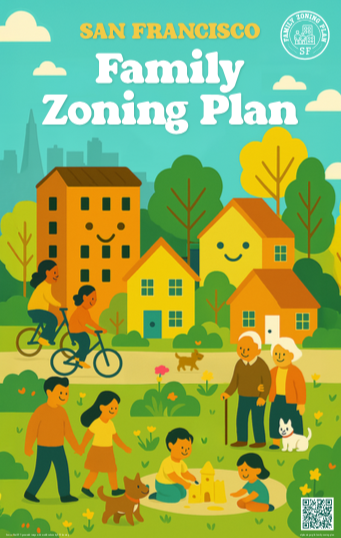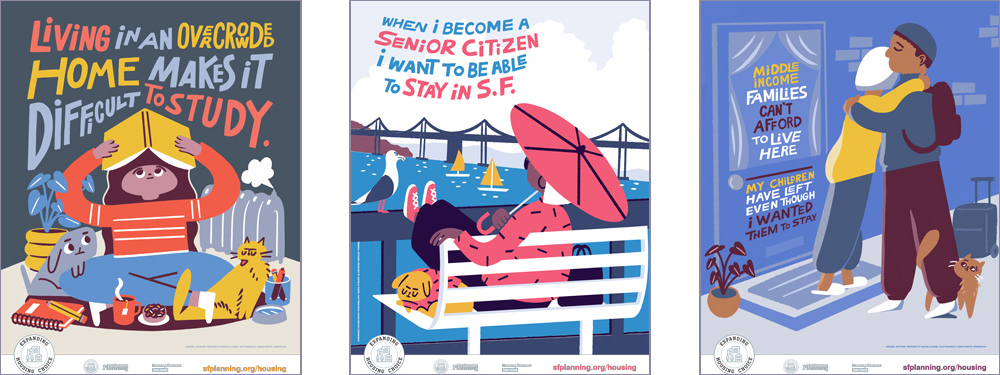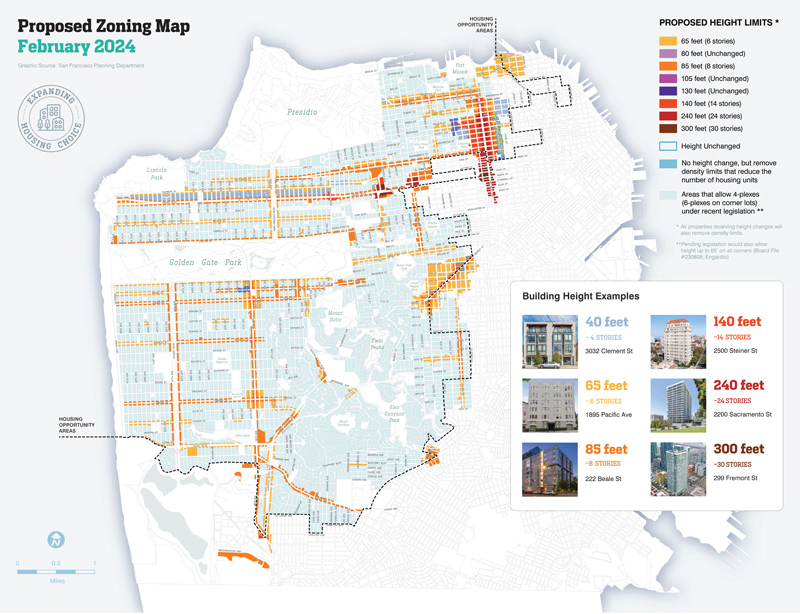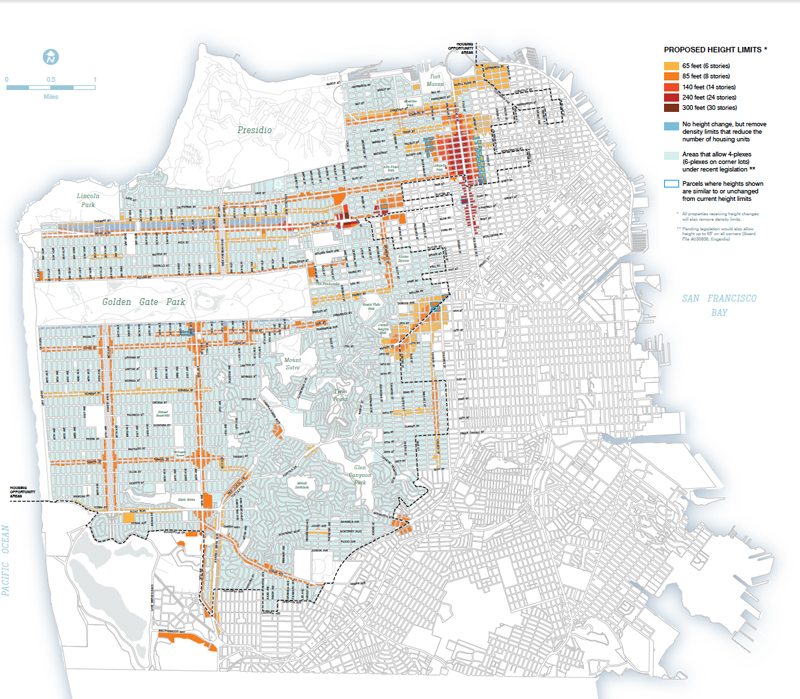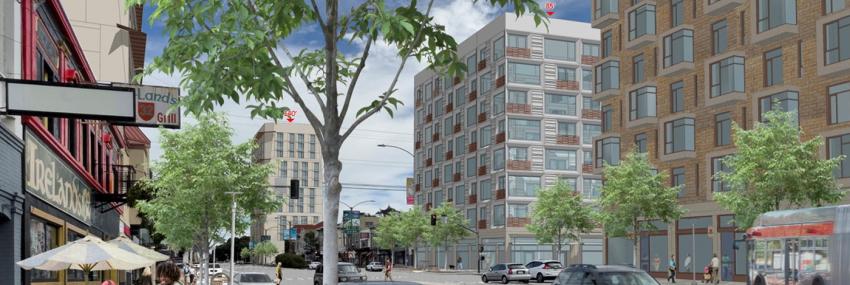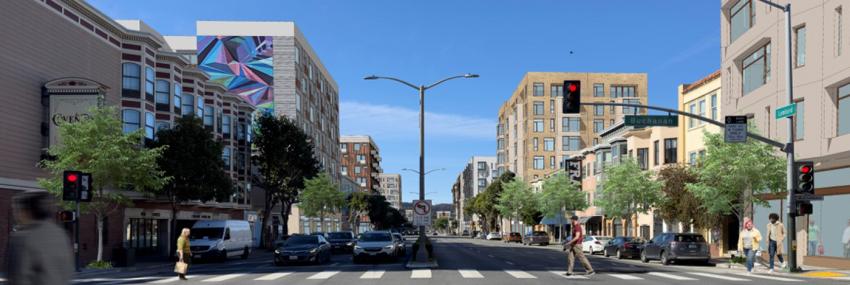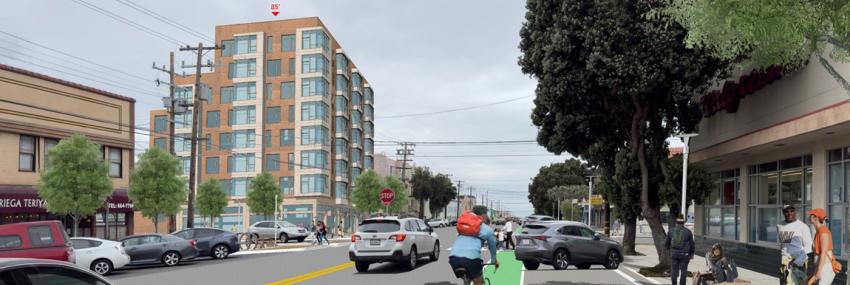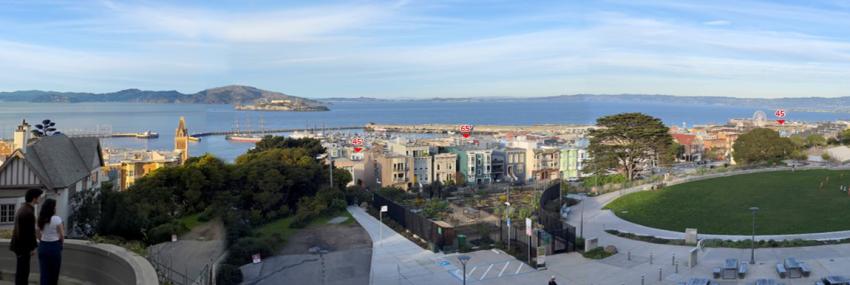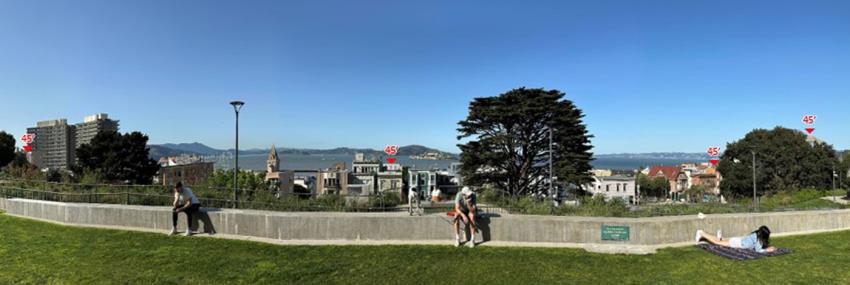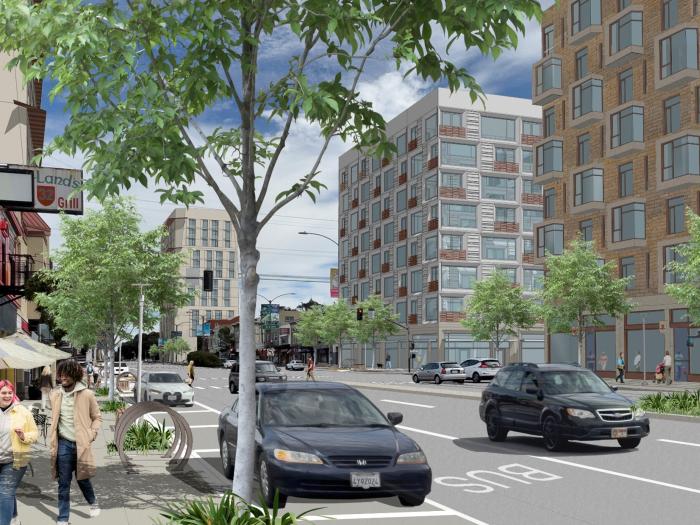
San Francisco Family Zoning Plan
The Family Zoning Plan has been approved!
On December 12, 2025, following more than three years of community engagement, plan development, and approvals by both the Planning Commission and the Board of Supervisors, Mayor Lurie officially signed the Family Zoning Plan into law. The ordinances will take effect on January 12, 2026.
You can find the final legislation here:
- Zoning Map Ordinance (Board File 250700)
- Planning Code Ordinance (Board File 250701)
- General Plan Amendments (Board File 250966)
- Local Coastal Program Amendment (Board File 250985)
Note: this webpage is in the process of being updated to reflect the final adopted Family Zoning Plan. Factsheets and Resources can be found under the 'About' tab of the webpage.
Factsheets and Resources
Factsheets and Resources
- Overview: What is the Family Zoning Plan?
- Factsheet: Rezoning Capacity Calculations
- Factsheet: Family Zoning Plan and SB 79 Compliance
- Factsheet: Small Business Protections
- Factsheet: Tenant Protections
- Factsheet: Historic Preservation and Family Zoning Plan
- Factsheet: What Happens if We Don't Rezone?
- Explore potential neighborhood designs (additional digital renderings)
- CA Department of Housing and Community Development Preliminary Review and Substantial Compliance Letter (September 2025)
Map and Legislation Updates
- View the Proposed Zoning interactive map
- View the proposed Local Program Height Map (December 1, 2025)
- View the proposed Base Height Map (September 30, 2025)
- Explainer Maps describing map layers in the Family Zoning Plan proposal
- Proposed amendments at the Board of Supervisors (October 20, November 3 and 17, December 1, 2025)
Resources will be updated as materials become available. Please continue to check back for updates, or sign-up to receive our email newsletter.
- 2025 Racial and Social Equity Analysis: San Francisco Family Zoning Plan
- Housing Element Fact Sheet
- Community Engagement Summary (Spring 2023 – Spring 2024)
- Community Stories and Experiences
- A Primer on RHNA: How much housing do we need?
Posters
Click on the image below to download.
Currently, the City's zoning rules limit the variety and types of housing that can be built and prevent us from building enough new housing to meet people’s needs. Most housing built in San Francisco in recent decades has been concentrated in the eastern neighborhoods, where zoning generally allows for mid-rise and high-rise developments. Meanwhile, the northern and western parts of the city have seen relatively little growth. These areas are primarily zoned for single-family development, which is less likely to be affordable to low- and middle-income residents and is shown to reinforce patterns of economic and racial segregation.
The Family Zoning Plan allows for more housing options in neighborhoods with greater access to economic opportunities and services that can support growth, such as public transit, parks, retail, and community facilities.
The Plan is one of the key implementation actions of San Francisco’s Housing Element. Under state law, San Francisco is required to adopt a compliant rezoning plan by January 31, 2026.
Some goals of the project include:
- Begin to reverse housing segregation in compliance with state requirements
- Strengthen our communities by adding new neighbors and resources
- Coordinate new development with investments in infrastructure and services
- Add more Affordable and diverse Housing
Outreach
Community Conversations: We can join your neighborhood group meeting to provide an informational presentation, answer questions, and discuss community concerns and ideas. Email us at sf.housing.choice@sfgov.org to schedule a conversation.
Upcoming Hearings
December 2, 2025: Board of Supervisors
December 1, 2025: Board of Supervisors - Land Use and Transportation Committee Hearing
Past Hearings
November 20, 2025: Planning Commission
November 17, 2025: Board of Supervisors - Land Use and Transportation Committee Hearing
November 3, 2025: Board of Supervisors - Land Use and Transportation Committee Hearing
November 3, 2025: Youth Commission
Family Zoning Plan Program Informational Presentation
October 20, 2025: Board of Supervisors - Land Use and Transportation Committee Hearing
Family Zoning Plan Program and the Affordable Housing Sites Analysis Strategy
September 11, 2025: Planning Commission
Plan Adoption Hearing
August 20, 2025: Historic Preservation Commission
Informational Presentation
July 28, 2025: Small Business Commission
Ordinance Amending the Zoning Map to Implement the Family Zoning Plan
July 17, 2025: Planning Commission
Infrastructure and the Affordable Housing Sites Analysis and Strategies - Informational Hearing
Initiation of General Plan Amendments
June 26, 2025: Planning Commission
Informational Hearing on the adoption process and changes made in response to feedback.
June 16, 2025: Land Use and Transportation Committee
Informational Hearing on upcoming legislative updates and outreach.
April 17, 2025: Planning Commission
Small Business Strategies – Informational Hearing
April 10, 2025: Planning Commission
Updated Proposed Zoning Map – Informational Hearing
February 27, 2025: Planning Commission
Tenant Protections: Replacement Units & Tenant Rights Informational Presentation
June 6, 2024: Planning Commission
Expanding Housing Choice Informational Presentation
April 4, 2024: Planning Commission
Expanding Housing Choice Memo to the Commission
February 21, 2024: Historic Preservation Commission
Expanding Housing Choice Informational Presentation
February 1, 2024: Planning Commission
Expanding Housing Choice Informational Presentation
November 30, 2023: Planning Commission
Expanding Housing Choice Informational Presentation
July 27, 2023: Planning Commission
Expanding Housing Choice Informational Presentation
April 27, 2023: Planning Commission
Housing for All Informational Presentation
Local Coastal Program Amendment
Notice of Availability of Local Coastal Program Amendments
Proposed Family Zoning Plan amendments to the San Francisco Planning Code, Planning Maps, and General Plan would apply to the Coastal Zone. After these amendments are adopted by the City, they will be submitted to the California Coastal Commission for certification as amendments to San Francisco’s Local Coastal Program.
Prior Events
| Event Information | Materials |
|---|---|
| Phase 2 Webinar 2023 December 13, noon – 1:00PM Location: Online | Review the webinar recording and presentation slide deck to learn about the progress we have made to better meet San Francisco’s housing needs through a Draft Zoning Proposal, Local Zoning Program, and additional strategies to support current and future residents and small businesses. |
| Open House 2023 November 8, 5:30PM - 7:30PM Location: SF LGBTQ Center, 1800 Market Street Open House 2023 November 15, 5:30PM - 7:30PM Location: County Fair Building, 1199 9th Avenue | |
| Phase 1 Webinar - Laying the Foundation 2023 September 14, noon – 1:00PM Location: Online | Review the webinar recording and presentation slide deck to learn about the Housing Element zoning program, Expanding Housing Choice. The webinar covers the background of the project and how we can make changes to better meet San Francisco’s housing needs, increase affordability for low- and middle-income households, and help advance racial and social equity. |
| Open House 2023 July 11, 5:30PM - 7:30PM Location: County Fair Building, 1199 9th Avenue Open House 2023 June 22, 5:30PM - 7:30PM Location: SF LGBTQ Center, 1800 Market Street |
|
Proposed Family Zoning Plan
Legislation Policy Updates
On June 24, 2025, Mayor Lurie introduced legislation at the Board of Supervisors to implement the Family Zoning Plan, including both a Planning Code Ordinance and a Zoning Map Ordinance. The legislation was adopted at the Planning Commission at the September 11, 2025 hearing, and it is now under consideration of adoption at the Board of Supervisors. Under state law, the legislation must be adopted by January 31, 2026. Below are links to the full legislative package.
Please visit the Board File links to view the detailed history and amendments for each component of the legislation. For a general overview and summary of the proposed changes, please refer to the staff report prepared for the Planning Commission’s September 11, 2025 hearing (which reflects the draft legislation as of that date).
The Board of Supervisors added amendments to the ordinances at the October 20, November 3 and 17, and December 1, 2025, Land Use & Transportation Committee hearings. Land Use & Transportation Committee hearings. The ordinances are continuing to be reviewed by the Board of Supervisors and are subject to change.
Zoning Map Ordinance (Board File 250700):
Planning Code Ordinance (Board File 250701)
- Legislative Digest
- Draft Ordinance
- Index of Planning Code Amendments
- Rezoning Lower Income Sites
- Housing Element 2022 Reused Sites
General Plan Amendments (Board File 250966)
Local Coast Program Amendment (Board File 250985)
Interactive Maps
The interactive map of the zoning proposal shows areas where changes are being suggested to allow more housing. It shows the planned height limits for buildings, including any bonus programs, like the state’s density bonus program. New housing may also continue to be built outside of these areas based on the current zoning rules.
PDF Maps
- View the Proposed Local Program Heights Map (opens in new browser window)
- View the Base Zoning Map (opens in new browser window)
- Explainer Maps describing map layers in the Family Zoning Plan proposal
The most recent draft of the Family Zoning Plan was published in June 2025. The Department will continue to collaborate with the Mayor’s staff to incorporate any requested changes and to prepare the final ordinances for introduction at the Board of Supervisors, which is anticipated in Summer 2025.
The proposed map continues to focus change on major transit routes, commercial streets, and other major thoroughfares and hubs of activity. Key components include:
- Mid-rise (6-8 stories) and high-rise housing (9+ stories) on all major transit and commercial streets. High-rise buildings are generally proposed for major intersections, transit hubs, and portions of corridors with the most frequent transit service.
- Removal of density restrictions in residential areas off the corridors, so that projects may build additional units within the existing height limit (typically 4 stories). Properties near selected commercial streets can get an extra floor (up to 5 stories).
- Corner lots and ‘opportunity sites’ larger than 8,000 square feet can go up to 6 stories.
Geography
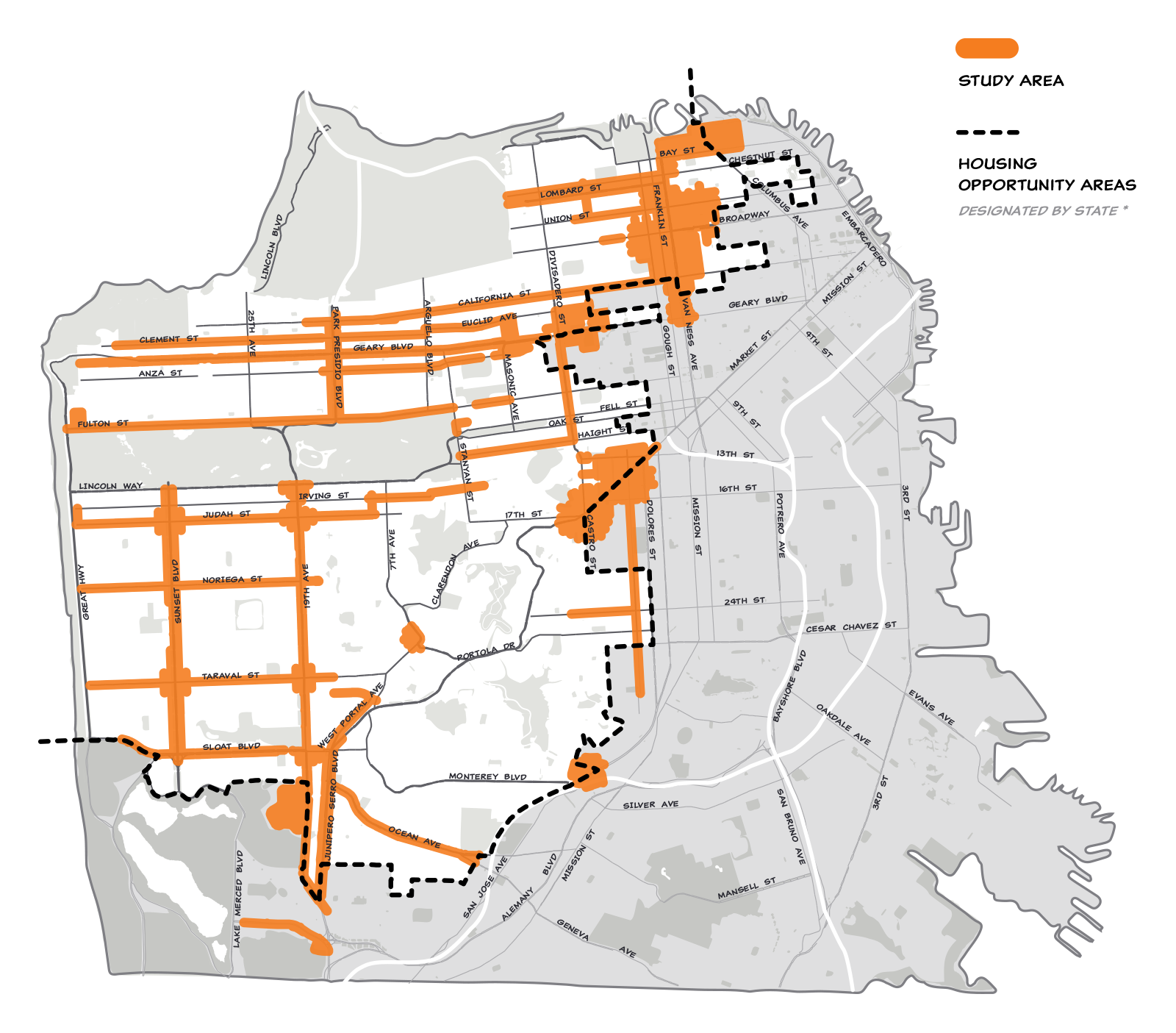 Map caption: This map illustrates corridors, nodes, and large sites that the City will prioritize for additional housing capacity. Other areas may be added during the community engagement and adoption process. View a larger map.
Map caption: This map illustrates corridors, nodes, and large sites that the City will prioritize for additional housing capacity. Other areas may be added during the community engagement and adoption process. View a larger map.Under state law, San Francisco must plan for roughly 36,000 housing units in the next eight years (2023-2031) to meet our city’s housing needs, on top of the housing units we already expect to be built. To foster more inclusive communities and undo the harmful effects of housing segregation and discrimination, the state requires that a significant share of new housing be built in neighborhoods with greater access to economic opportunities and services that can support growth, such as public transit, parks, retail, and community facilities.
Allowing for more and different types of housing in these neighborhoods helps ensure that more residents have access to housing that meets their needs, while strengthening community resources, infrastructure, and other services. New residents will also benefit from good access to public transportation, requiring fewer vehicle trips to access goods and services and reducing air pollution, including greenhouse gasses.
The City’s approach to increasing residential density in these neighborhoods will consider the need to protect communities vulnerable to displacement. It will also coordinate new development with improvements to infrastructure and services to ensure that new housing does not overburden our existing resources.
Previous Family Zoning Plan Versions
Draft Zoning Proposal (April 2025)
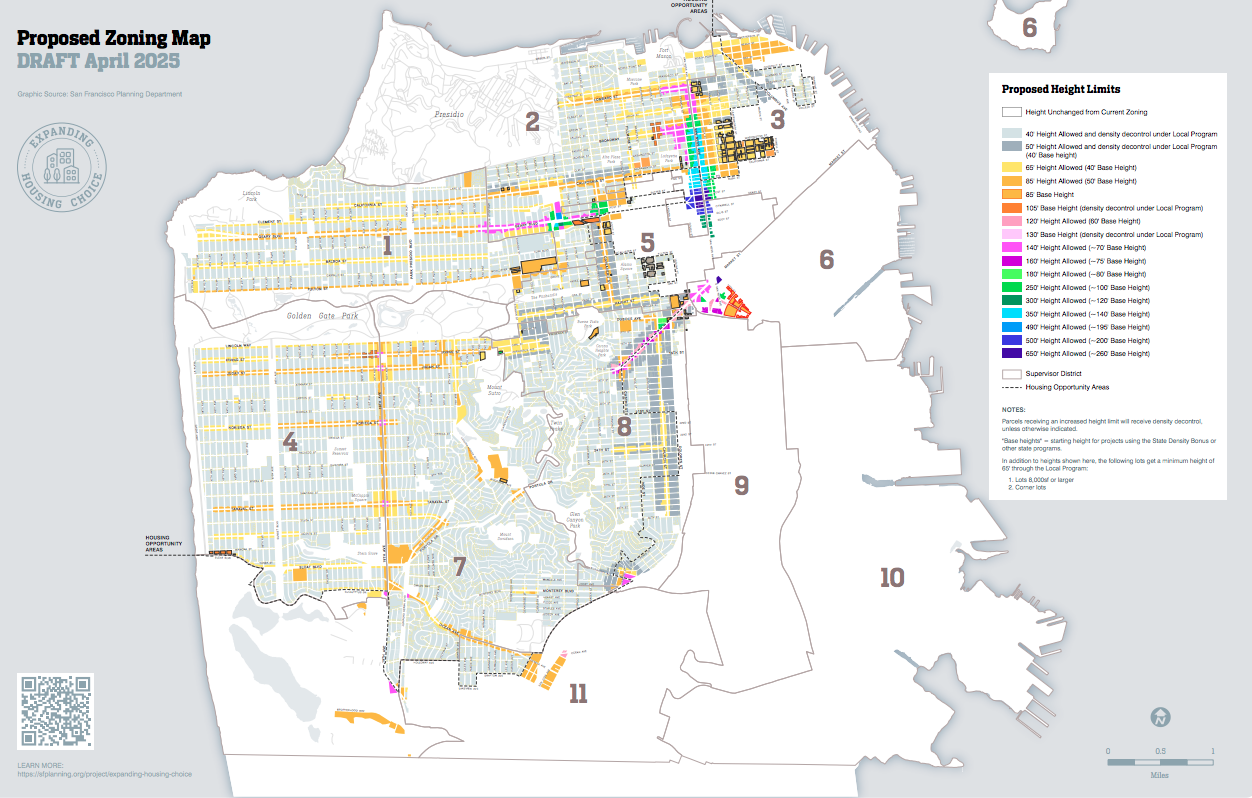
Map caption: A map showing proposed housing height limits in San Francisco published in April 2025. Click on image to enlarge.
Proposed Supervisor District Maps
These digital renderings show examples of how neighborhoods across the city could evolve through the new Family Zoning Plan.
- Explore how neighborhoods may look with new housing (example digital renderings)
Hearing Info
Contact
For questions on the project or to request a meeting with the Planning Department on the Expanding Housing Choice, email sf.housing.choice@sfgov.org
Review Process
The Planning Commission adoption hearing will be advisory to the Board of Supervisors which has final approval authority. After the Planning Commission hearing, the legislation will be considered by the Board of Supervisors' Land Use and Transportation Committee, where there will also be an opportunity for public comment. Following the Land Use and Transportation Committee hearing(s), the legislation will be heard by the full Board of Supervisors, which must pass the ordinances twice before they can be sent to the Mayor. If passed by the Board and signed by the Mayor, the proposed changes will become effective 30 days after the Mayor signs the ordinances.
Hearing Information
If you received a mailed postcard notice, you are receiving notification because either you are a property owner, resident or business tenant that is adjacent to the proposed rezoning area, or are an interested party on record with the Planning Department. You are not required to take any action. For more information regarding the proposed rezoning, or to express concerns or convey comments, please contact the project team listed under the "Contacts" tab. Additionally, you may wish to discuss the rezoning effort with your neighbors and/or neighborhood association as they may already be aware of the effort.
Persons who are unable to attend the public hearing may submit written comments regarding this application to the Planner listed on the front of this notice by emailing sf.housing.choice@sfgov.org, or mailing the Family Zoning Plan Team, Planning Department, 49 South Van Ness Avenue, Suite 1400, San Francisco, CA 94103, by 5:00 pm the day before the hearing. These comments will be made a part of the official public record and will be brought to the attention of the person or persons conducting the public hearing.
Comments that cannot be delivered by 5:00 pm the day before the hearing may be taken directly to the hearing at the location listed on the front of this notice. Comments received at 49 South Van Ness Avenue after the deadline will be placed in the project file, but may not be brought to the attention of the Planning Commission at the public hearing.
Información y recursos para audiencias
Contacto
Para preguntas sobre el proyecto o para solicitar una reunión con el Departamento de Planificación sobre la expansión de la elección de vivienda, envíe un correo electrónico a sf.housing.choice@sfgov.org.
Proceso de Revisión
La audiencia de adopción de la Comisión de Planificación asesorará a la Junta de Supervisores, que tiene la autoridad final para la aprobación. Después de la audiencia de la Comisión de Planificación, la legislación será considerada por el Comité de Uso de Tierras y Transporte de la Junta de Supervisores, donde también habrá una oportunidad para comentarios públicos. Tras la(s) audiencia(s) del Comité de Uso de Suelo y Transporte, la legislación será vista por la Junta de Supervisores en pleno, que deberá aprobar las ordenanzas dos veces antes de que puedan ser enviadas al Alcalde. Si la Junta las aprueba y el Alcalde las firma, las modificaciones propuestas entrarán en vigor 30 días después de que el Alcalde las firme.
Información Sobre la Audiencia
Si recibió una notificación por correo postal, la recibe porque es propietario, residente o inquilino comercial de una propiedad adyacente a la zona de rezonificación propuesta, o porque es parte interesada registrada en el Departamento de Planificación. No está obligado a realizar ninguna acción. Para obtener más información sobre la rezonificación propuesta, o para expresar inquietudes o comentarios, comuníquese con el equipo del proyecto que figura en la pestaña "Contactos". Además, le recomendamos hablar sobre la rezonificación con sus vecinos o la asociación de vecinos, ya que es posible que ya estén al tanto.
Quienes no puedan asistir a la audiencia pública pueden enviar sus comentarios por escrito sobre esta solicitud al Planificador que figura en el anverso de este aviso enviando un correo electrónico a sf.housing.choice@sfgov.org o por correo postal al Equipo del Plan de Zonificación Familiar, Departamento de Planificación, 49 South Van Ness Avenue, Suite 1400, San Francisco, CA 94103, antes de las 5:00 p. m. del día anterior a la audiencia. Estos comentarios formarán parte del registro público oficial y se pondrán en conocimiento de la persona o personas que celebren la audiencia pública.
Los comentarios que no puedan entregarse antes de las 5:00 p. m. del día anterior a la audiencia se podrán llevar directamente a la audiencia en el lugar que figura en el frente de este aviso. Los comentarios recibidos en 49 South Van Ness Avenue después de la fecha límite se incluirán en el expediente del proyecto, pero no podrán presentarse a la Comisión de Planificación en la audiencia pública.
Recursos
聽力資訊和資源
聯絡
如對計劃有任何疑問,或要求與規劃部門就擴大住房選擇舉行會議,請發送電子郵件至 sf.housing.choice@sfgov.org.
評審流程
规划委员会通过听证会将为参事会提供咨询意见,参事会拥有最终批准权。规划委员会听证会结束后,参事会的土地使用和交通委员会将审议该立法,届时还将有机会听取公众意见。在土地使用和交通委员会听证会之后,立法将由参事会全体成员进行听证,参事会必须两次通过法令,才能将其提交给市长。如果获得参事会通过并由市长签署,拟议的修改将在市长签署法令 30 天后生效。
聆訊資訊
如果您收到了邮寄的明信片通知,您之所以收到通知,是因为您是毗邻拟议改划区域的业主、居民或企业租户,或者是在规划局备案的利益相关方。您无需采取任何行动。如需了解有关拟议重新分区的更多信息,或表达疑虑或转达意见,请联系 “联系人 ”标签下所列的项目团队。此外,您可能希望与邻居和/或居委会讨论重新分区工作,因为他们可能已经了解这项工作。
無法出席公聽會的人士可於公聽會前一天下午 5:00 前,將有關本申請的書面意見發送至本通知正面所列的規劃師,電子郵件地址為 sf.housing.choice@sfgov.org,或郵寄至規劃部家庭分區計劃小組,地址為 49 South Van Ness Avenue, Suite 1400, San Francisco, CA 94103。这些意见将作为正式公开记录的一部分,并提请举行公听会的人员注意。
未能在听证会前一天下午 5:00 之前送达的意见,可直接送达本通知正面所列的听证会地点。截止日期后在49 South Van Ness收到的意见将存入项目档案,但不得在公听会上提请规划委员会注意。
資源
Impormasyon sa Pagdinig at Mga Mapagkukunan
Contact
Para sa mga katanungan tungkol sa proyekto o upang humiling ng isang pagpupulong sa Departamento ng Pagpaplano sa Pagpapalawak ng Pagpipilian sa Pabahay, mag-email sa sf.housing.choice@sfgov.org.
Proseso ng Pagrerepaso
Ang pagdinig sa pag-aapruba ng Planning Commission ay magiging payo sa Board of Supervisors na may pinal na awtoridad sa pag-apruba. Pagkatapos ng pagdinig sa Planning Commission, ang batas is isasaalang-alang ng Land Use and Transportation Committee ng Board of Supervisors, kung saan magkakaroon din ng pagkakataon para sa komento ng publiko. Kasunot ng mga pagdinig ng Land Use and Transportation Committee, ang batas ay didinggin ng Board of Supervisors, na kailangang ipasa ang mga ordinansa ng dalawang beses bago ito maipadala sa mayor. Kung naipasa ng Board at nilagdaan ng mayor, ang mga panukalang pagbabago ay magiging epektibo 30 araw matapos lagdaan ng mayor ang mga ordinansa.
Impormasyon Tungkol Sa Pagdinig
Kung nakatanggap ka ng isang paunawa sa postcard na ipinadala sa koreo, nakatanggap ka ng notice dahil sa ikaw ay isang may-ari ng ari-arian, residente o nangungupahan ng negosyo na katabi ng iminungkahing lugar ng rezoning, o isang interesadong partido na nakatala sa Planning Department. Hindi mo kailangang gumawa ng anumang aksyon. Para sa karagdagang impormasyon tungkol sa iminungkahing rezoning, o upang ipahayag ang mga alalahanin o maghatid ng mga komento, mangyaring makipag-ugnay sa grupo ng proyekto na nakalista sa ilalim ng tab na "Mga Contact." Bilang karagdagan, maaari mong talakayin ang pagsisikap sa pag-rezoning sa iyong mga kapitbahay at / o samahan ng kapitbahayan dahil maaaring alam na nila ang pagsisikap.
Ang mga taong hindi makadalo sa pampublikong pagdinig ay maaaring magsumite ng mga nakasulat na komento tungkol sa aplikasyon na ito sa Planner na nakalista sa harap ng notice na ito sa pamamagitan ng pag-email sa sf.housing.choice@sfgov.org, o pagpapadala ng koreo sa Family Zoning Plan Team, Planning Department, 49 South Van Ness Avenue, Suite 1400, San Francisco, CA 94103, bago sumapit ang 5:00 pm isang araw bago ang pagdinig. Ang mga komentong ito ay gagawing bahagi ng official public record at dadalhin sa attensyon ng tao o mga taong nagsasagawa ng pampublikong pagdinig.
Ang mga komento na hindi maihahatid bago mag-alas-singko ng hapon (5:00 PM) ay maaaring dalhin nang direkta sa lokasyon ng hearing na nakalista sa harap ng notice na ito. Ang mga komento na tanggap sa 49 South Van Ness Avenue pagkatapos ng deadline ay ilalagay sa file ng proyekto, ngunit hindi maaaring dalhin sa atensyon ng Planning Commission sa public hearing.
Resources
Click on a question marker to open/close the view.
What is Mayor Lurie’s Family Zoning Plan?
What is the SF Family Zoning Plan?
Family Zoning Plan is a set of changes to San Francisco’s restrictive zoning rules that will allow new homes to be built in more neighborhoods across the City. These changes are required by state law and focus on property in the western and northern parts of San Francisco, specifically in and near the areas designated by the state as Housing Opportunity Areas, which are neighborhoods with greater access to parks, quality schools, better environmental conditions, and with higher median incomes. This rezoning is required by the City’s Housing Element. Under state law, the rezoning must be adopted by January 2026. Mayor Lurie introduced the San Francisco Family Zoning Plan in June 2025 and will be heard at Planning Commission and the Board of Supervisors in Fall Summer 2025.
What will rezoning look like? Are there any renderings?
These digital renderings show examples of how neighborhoods across the City could evolve.
How much housing does San Francisco need?
While San Francisco has built more housing, including affordable housing, in recent years than many other Bay Area cities, housing production in both the City and the broader Bay Area have not kept pace with population and economic growth over the past several decades. This shortage of housing has caused home prices to soar in recent decades, and many residents are vulnerable to being priced out of San Francisco and California. The state’s increased housing requirements mean that every jurisdiction will need to build more to address current needs and these long-term trends
Under these requirements, San Francisco needs to plan for the construction of at least 82,069 housing units affordable to different income levels between 2023 and2031, or about 10,000 units annually – this is known as our Regional Housing Needs Allocation (RHNA, commonly pronounced “Ree-Na”). This figure is almost three times higher than the City’s previous RHNA requirement (in the period between 2014 and 2022). This was driven by the need to consider our unmet housing needs – that is, people who are living in overcrowded conditions, and renters and homeowners who are cost burdened and struggling to make ends meet. In short, these numbers reflect the fact that too many San Franciscans live under precarious and inadequate housing conditions.
To get to 82,069 units, the City can factor-in housing units that are already in the development “pipeline” and expected to be built before 2031, in addition to additional housing construction that could reasonably be expected under existing zoning.
Where can I see the draft proposed rezoning map?
The most recently proposed map, including prior published drafts can be found under the Renderings tab.
The Department will continue to collaborate with stakeholders to incorporate any requested changes and to prepare the final ordinances for action by the Board of Supervisors
The proposed rezoning continues to focus change on major transit routes, commercial streets, and other major thoroughfares and hubs of activity. Key components include:
- Mid-rise (6-8 stories) and high-rise housing (9+ stories) on major transit and commercial streets. High-rise buildings are generally proposed at major intersections, transit hubs, and portions of corridors with the most frequent transit service.
- Form-based zoning (i.e. limiting residential density by the allowable building size rather than the size of the lot, or some other arbitrary figure) in residential areas off the corridors, where limits on building size will remain unchanged, so that projects may build additional units within the existing height limit (typically 4 stories). Properties near selected commercial streets can get an extra floor (up to 5 stories).
- Corner lots and “opportunity sites” larger than 8,000 square feet can go up to six stories.
How does the rezoning interact with state housing laws, like the state density bonus law?
San Francisco’s rezoning plan sets baseline zoning standards that meet state requirements—but it also goes further to create a local bonus program that creates additional housing capacity while preserving local control.
To complement state law, the plan introduces Housing Choice San Francisco, a new local housing bonus program designed as an alternative to the State Density Bonus Law, a state program that offers additional height and density to projects that provide an increased number of affordable units. Housing Choice San Francisco creates an alternative local program that offers projects more flexibility in how affordable housing is delivered—without sacrificing the design standards and neighborhood character that matter to our communities
If the City does not take proactive steps like this, it risks losing access to state funding and forfeiting control over where and how housing is built. By acting now, the rezoning ensures we stay in compliance with state law while protecting our ability to shape growth thoughtfully and equitably.
Unlike the State Density Bonus Law, the local housing bonus program:
- Maintains design and architectural standards while streamlining approvals;
- Offers multiple ways to meet affordable housing goals, including on-site units, off-site land dedication, providing rent-controlled units, or paying an affordable housing fee;
- Applies where it makes sense—on commercial corridors, near transit, and on large lots;
- Allows moderate-scale infill in residential neighborhoods with duplexes, triplexes, or four-plexes—so more housing opportunities are distributed across the city, not concentrated in certain areas.
The local program is a strategic response to state mandates, giving San Francisco the tools to lead with its own policies, rather than relying solely on state defaults.
Where is this happening?
Why does the rezoning prioritize certain areas of the city, rather than rezoning the entire city?
To promote inclusive communities and address housing segregation, the state mandates that a substantial portion of new housing, including affordable housing, be constructed in neighborhoods with better access to economic opportunities and essential services, such as public transit, parks, shops, and community facilities. These neighborhoods are primarily concentrated in the northern and western parts of the City. In addition to proximity to transportation and services, the rezoning is looking at the areas likeliest to produce housing, particularly those streets with vacant commercial buildings, parking lots, while considering ways to increase ability to add multi-family housing in surrounding areas. The proposed map continues to focus change on major transit routes, commercial streets, and other major thoroughfares and hubs of activity.
Much of the eastern and southern parts of San Francisco have already been rezoned in the past. These areas can and have accommodated most of the city’s new housing in the past two decades. We expect to continue to see tens of thousands of new housing units in these areas.
Why does the current zoning need to be updated?
Why does the current zoning need to be updated?
Existing zoning needs to be updated to allow for more housing while also supporting the City’s equity goals. San Francisco has historically prohibited new multi-family buildings in more affluent parts of the City, resulting in socioeconomic and racial exclusion from these neighborhoods while also concentrating development on lower-income neighborhoods where denser development is allowed. In the past 20 years, the City has rezoned neighborhoods on the eastern side of the City to create more housing capacity in neighborhoods like SoMa, the Mission, Potrero Hill, and the Central Waterfront. The City now must further make broader zoning changes to allow more housing opportunities citywide.
The current proposed rezoning program focuses on higher-income western and northern San Francisco neighborhoods where restrictive zoning polices currently make it challenging or impossible to build new multifamily housing, which offers more diverse and affordable housing options. Over the past 15 years, only 10% of San Francisco’s new housing has been built in these western and northern areas, even though they cover over 50% of the City’s land area. State and City policies require us to add housing in the western and northern areas of the City so that we can create housing opportunities for low- and moderate-income households in well-resourced neighborhoods and work to reverse historic patterns of economic and racial segregation.
What happens if we don’t rezone?
Without compliant rezoning legislation by January 2026, San Francisco risks losing State certification of the Housing Element, which could lead to a loss of vital state grants that the City relies on. These grants total hundreds of millions of dollars, and are used to build affordable housing, pave city streets, and keep MUNI and other key City services running. Failure to comply could also lead to lawsuits and state-imposed penalties, including fines and forced approval of “builder’s remedy” projects. That means that the City would lose the ability to apply any kind of zoning rules (including today’s height, density, and setback rules). In other words, the City would lose local control over the housing it currently approves, allowing the state to approve many kinds of developer projects with few, if any, limits.
Other California cities are already facing this problem because they don’t have certified Housing Elements or are soon to face it because they haven’t completed actions they committed to in their Housing Elements. A significant number of cities are facing large “builder’s remedy” projects across the state, including cities such as Redondo Beach, Santa Monica, Menlo Park and Palo Alto. The state has seen a series of dramatic legal rulings and settlements, including a Beverly Hills case where a judge suspended the city’s permitting power because the city didn’t have a valid housing element. Similarly, the city of Davis – which was also without a certified Housing Element - was forced to approve a project that violated zoning rules and would have otherwise required voter approval.
Why do we have to rezone if there are vacant units in San Francisco today?
The latest census data from 2022 shows the City's rental vacancy rate at approximately 5.5% and homeownership vacancy rate at 0.8%, which are both below the national average.
Recent studies indicate that in cities like San Francisco, where there are fewer vacant homes available for rent or sale and housing costs are extremely high, more individuals are susceptible to homelessness. This poses significant challenges, especially for those with low incomes. Research recommends promoting the construction of new homes across various parts of the city through initiatives such as rezoning. Go Deeper: Housing Vacancies and Homeownership - Press Release
In a typical housing market, at least 5% of units are expected to be vacant and available for rent or sale at any given time, and a rate between 5-10% is not unusual nationally. This level is important to allow people the ability to move, find available housing in a range of neighborhoods and types of housing, and ensure low availability doesn't put undue pressure to raise prices. And it is expected for units and buildings to undergo renovation and maintenance over time as buildings age. Higher than typical vacancy rates matter, and the voter-approved vacancy tax is one way in which the City is addressing the issue.
While efforts to encourage landlords to rent out vacant units are ever-evolving and important, they will not adequately address the scale of our present and future housing needs or fulfill the commitments outlined in our certified Housing Element. State law mandates rezoning to address San Francisco's Regional Housing Needs Allocation shortfall, which is 36,200 units. Relying on existing homes will be insufficient to alleviate the housing shortage or to meet our obligation.
Can empty offices be used to fulfill our housing requirements?
San Francisco, like many cities, is facing high office vacancy rates. The City is actively encouraging the conversion of office buildings into housing and has already changed our zoning to facilitate this process. However, conversions involve extraordinarily complex and expensive renovations that are layered on top of the same challenges facing all housing projects, like high construction costs and interest rates. Moreover, most office buildings are not suitable for conversion due to their layout and lack of appropriately available residential necessities like windows and ventilation. Nonetheless, the City has created a Downtown Adaptive Reuse Program to make it easier and faster to convert underutilized commercial buildings into housing, which includes waiving the inclusionary housing requirement and impact fees for eligible adaptive reuse projects.
How will new housing impact infrastructure and transportation in the City?
The Family Zoning Plan is a collaborative effort with City departments to align housing growth with essential infrastructure and services for healthy, connected, and resilient communities. New housing will be added gradually, and City agencies are planning ahead to enhance infrastructure and community facilities to meet the pace of growth. Key infrastructure and service agencies, like SFMTA, SFPUC, Rec Park, and SFUSD routinely maintain and update their own long-range plans informed by population and housing growth projections, and the City’s Capital Planning Committee updates the city’s 10-year Capital Plan every two years.
How have residents and property owners been notified of the rezoning?
Details
Given the broad geography of the rezoning work, engagement activities included a mix of in-person and virtual events – ranging from smaller gatherings like focus groups and community conversations (which are one-on-one meetings with community groups), to larger events like open houses. These efforts were designed to engage a diverse cross-section of community members and gather a wide range of perspectives to inform the zoning proposal.
Understanding that communities most impacted by the lack of affordable housing often face the greatest barriers to participation, the project team partnered with organizations serving renters, seniors, families, immigrants, communities of color and other vulnerable groups. These partnerships helped ensure that these voices were not only included but centered in the planning process.
Here are some examples of the ways we have encouraged San Franciscans to engage with SF Planning on the Family Zoning Plan:
- Community workshops
- Open Houses
- Focus Groups
- Housing Education Workshops
- Community Conversations and Office Hours
- Surveys
- Webinars
- Email Communications
- Public Service Announcements on MUNI
- Planning website, planning commission hearings, public workshops
- We continue to meet with stakeholders as requested
Additionally, we will be sending out a mailed notice in advance of the adoption at the Planning Commission.
How will this impact my neighborhood?
Will this cause many buildings to be demolished?
Our current laws successfully discourage demolitions of homes. Demolitions make up just 4% of no fault evictions, - that number drops to 2-3% when adding “just cause” evictions – and they have remained rare even during boom periods. The other 96% of evictions – mostly due to the Ellis act, owner move-ins, and capital improvements – are in part symptoms of our hyper competitive housing market which provides greater incentives for landlords to evict their tenants.
From 2012-2025, records show that 269 Units have been demolished, or roughly 20 units per year. Over half of these units were single family homes. During this same time, roughly 2 units were built for every unit lost.
Will the updated zoning help create new development in our neighborhoods?
Zoning is an important part of creating sustainable and equitable communities that increase access to economic activity and allow new homes and businesses. Expanding Housing Choice focuses on increasing housing capacity in the Housing Opportunity Area, on streets with commercial and transit where development is most likely to happen. Zoning changes do not force new developments to happen. The City generally does not directly build housing, and new housing mostly depends on property owners and economic conditions for construction.
Would new zoning require changes to existing buildings?
No, changes to existing buildings or demolition of existing buildings would not be required when the zoning is updated. Owners would maintain the same control over their property that they have today. However, if a property owner chose to rebuild their property, the rezoning may allow for more homes on a single parcel than were allowed previously.
How will this impact historic buildings?
Listed historic resources will continue to be subject to protections. The rezoning encourages or in certain cases requires continued preservation of designated historic resources. The City is continuing to diligently carry-out the San Francisco Citywide Cultural Resources Survey (SF Survey), a multi-year effort to protect our cultural heritage by identifying and documenting places and resources of cultural, historical, and architectural importance to San Francisco’s diverse communities. In addition, a bolstered historic landmark program continues to identify and designate our most important historic resources and confer both recognition and protection.
Buildings identified as cultural and historic resources will be subject to review processes designed to preserve our heritage while still allowing for new housing. SF Survey provides detailed information on many buildings, helping identify candidates for the City’s local landmark program, which offers the highest level of protection.
Importantly, historic designation does not prevent new housing. It does, however, require a more thoughtful, context-sensitive approach to ensure that any new development respects and integrates a property’s historic character.
What resources exist for small businesses that may be impacted by the rezoning?
City agencies are working to develop programs and policies to support small businesses in advance of the rezoning adoption.
The Office of Small Business offers several programs that provide technical assistance and grant funding to maintain the small businesses ecosystem in San Francisco. In some instances, new development arising from the rezoning may replace older commercial buildings, and the Office of Small Business offers relocation assistance services that can help impacted business owners.
How will this work impact housing?
Will rezoning increase affordable housing?
By increasing allowable heights and densities, along with other complementary strategies, The Family Zoning Plan has the potential to improve housing affordability by:
1) Increasing housing supply and variety – new construction can help lower housing costs by better meeting demand and creating a wider range of housing types (e.g., multifamily) that are typically more affordable than single family homes. Studies consistently show that easing height and density limits increases overall housing supply, which in turn can stabilize or reduce rents and home prices, particularly at the regional scale. Cities like Boston, Sacramento, and Minneapolis are already seeing these trends take effect. The rezoning and related efforts will increase the variety and types of housing available, adding fourplexes, accessory dwelling units (ADUs), townhomes, and mid-sized multi-family buildings, all of which tend to be more affordable than single-family homes. Additionally, many studies conclude that market-rate housing development causes decreases in rents in nearby rental buildings.
2) Encouraging filtering through new market-rate housing – Allowing the construction of new, even higher-end housing – enables higher income households move into newer buildings, thereby freeing up older, lower-cost units. This natural process, known as filtering, increases the availability of more affordable housing options for lower-income residents and reduces pressure on existing lower-cost neighborhoods.
3) Generating deed-restricted affordable housing through inclusionary requirements – New housing projects with 10 or more units are subject to San Francisco’s inclusionary housing requirements, which mandate that at least 15% of the units be affordable, or, alternatively, developers can pay a fee. These fees help fund the construction of 100% affordable housing elsewhere. The Family Zoning Plan’s proposed Local Program would allow projects that pay the inclusionary fee to qualify for the zoning incentives, something not permitted under the state density bonus program. In addition, San Francisco voters approved Proposition A in 2024, which will provide $300 million in new funding for affordable housing, some of which will directly support development in rezoning areas.
4) Unlocking sites for 100% affordable housing development – The rezoning will reduce key regulatory barriers and expand the number of sites that are viable for 100% affordable multifamily housing—especially on larger parcels of 8,000-10,000 square feet or more, which are typically needed for developments of 100 to 130 units. By making these sites more feasible, the plan directly supports the city’s ability to build deeply affordable homes at scale.
What protections exist for tenants who live in areas subject to the rezoning?
The City is working to enhance existing robust tenant protections, help safeguard against displacement, and boost housing stability. Key tenant protections that will continue to apply include the following:
1. Rent Control
- Applies to most multi-family buildings built before June 1979
- Limits annual rent increases and provides eviction protections
- Remains in effect regardless of zoning changes
2. Just Cause Eviction Protections
- Applies to most tenants after 12 months of occupancy, including those in newer buildings. Landlords can only evict tenants for specific, legally defined “just causes,” such as non-payment of rent or owner move-in.
3. Ellis Act and Owner Move-In Regulations
- If a landlord seeks to withdraw a unit from the rental market under the Ellis Act or move in themselves, they must follow strict notification, relocation, and timing rules.
- Additional protections exist for vulnerable tenants (e.g. seniors, people with disabilities).
4. Right of Return
- State law (SB330) Bans the demolition of affordable or rent-controlled units unless developers replace them, provide relocation assistance, and offer displaced tenants the first right of return at the same rent.
5. Inclusionary Housing
- Individuals who have been displaced from their prior housing in the City are eligible for priority access to Inclusionary Affordable Housing units that have been built as a requirement of larger new housing projects.
How can I get involved?
How can I get involved and stay informed?
As the rezoning moves through the adoption process, it will continue to be discussed at hearings at the Planning Commission and the Board of Supervisors; each of these venues is open to the public and provides the opportunity for participation and comment.
Sign up here to receive updates, as well as notifications about how to get involved.
Will my input and feedback be considered during the rezoning process?
Yes! The feedback the City receives has – and will continue to – directly inform zoning proposals. Over the last several years of outreach, San Franciscans shared perspectives from across the spectrum along with personal stories and experiences that continue to resonate with many community members and decision makers.
For a detailed overview of how feedback has shaped the process to date, please review Phase 1 and Phase 2 Community Engagement Summary and watch one-on-one interviews with community members.
For ongoing project updates, click here to subscribe to our email newsletter. For questions or media inquiries on the project, email sf.housing.choice@sfgov.org or contact:
Lisa Chen
Principal Planner, Project Manager
lisa.chen@sfgov.org
628.652.7422
David Garcia
Planner, Community Outreach Lead
david.h.garcia@sfgov.org
628.652.7433

